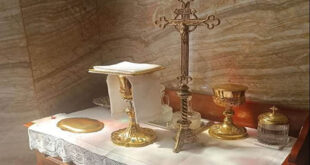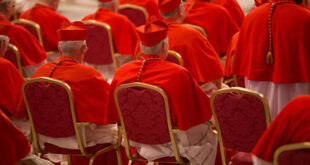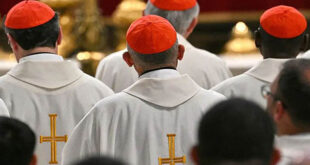The Catholic liturgy, rich in symbolism and tradition, uses colors as a powerful form of communication. Through liturgical colors, the Church invites us to enter the various moments of Christ’s life, the life of the Church, and each Christian’s journey of faith. Although they may often go unnoticed, liturgical colors speak to us, guide us, and immerse us in the mystery of faith. In this article, we will explore their history, the theological symbolism of each color, and how we can find inspiration and guidance in these colors that accompany the liturgical year.
1. History of Liturgical Colors: A Glimpse into Tradition
The practice of using specific colors in the Catholic liturgy has its roots in the Church’s history, though it was not always as structured as it is today. In the early centuries of Christianity, celebrants did not use specific vestments or codified colors. It wasn’t until the High Middle Ages that a system of liturgical colors was developed to better express the spirit of each celebration. In the 12th century, Pope Innocent III proposed a color system that became more established by the Council of Trent in the 16th century, when colors were officially established.
The Church, inspired by Scripture and tradition, came to recognize the power of colors to express feelings and heart dispositions, linking them to the life of Christ and the mysteries of faith. Finally, in 1969, with the liturgical reform of the Second Vatican Council, the Roman Missal modernized the use of these colors to better adapt them to the spirituality and understanding of contemporary Catholics.
2. Meaning and Symbolism of Each Liturgical Color
Each color used in the liturgy is full of meaning, and it not only marks the liturgical time but also invites the faithful to a particular spiritual disposition. Knowing the symbolism of each color helps us live more deeply in each liturgical season.
White: The Light of Christ
- Symbolism: White symbolizes purity, glory, resurrection, and the joy of eternal life. It is the color of the Risen Christ, the Virgin Mary, and the saints.
- Celebrations: White is used during the Easter and Christmas seasons, and for feast days of saints who were not martyrs, like the Virgin Mary. It is also used in the Eucharist.
- Practical Application: We can bring white into our daily lives as a symbol of renewal and hope. By wearing light-colored clothing or adorning a prayer space in white tones, we are reminded of the joy of the resurrection. White also invites us to live a life of purity and seek light in our daily decisions.
Red: The Fire of the Spirit and the Blood of Martyrdom
- Symbolism: Red represents the fire of the Holy Spirit, the passion of Christ, and the martyrdom of those who gave their lives for the faith.
- Celebrations: Red is used on Pentecost, the feast of the apostles and martyrs, and Palm Sunday.
- Practical Application: In moments of trial, red reminds us of bravery and witness. We can place a red candle in our prayer space on feast days of the Holy Spirit, invoking His power and renewal in our lives.
Green: Hope and New Life
- Symbolism: Green is the color of hope, new life, and growth in Christ. It represents Ordinary Time, which is a time of growth and daily life in faith.
- Celebrations: It is the predominant color in Ordinary Time when there is no special celebration, and the Church meditates on the life and teachings of Jesus.
- Practical Application: Green reminds us that faith is cultivated day by day. In times of calm or routine, green invites us to continue growing and persevering. Adding plants to the home or keeping a green item nearby reminds us to keep hope and spiritual growth alive.
Purple: Penitence and Conversion
- Symbolism: Purple, a color of penitence and preparation, is used to express conversion and deep reflection on the mystery of God.
- Celebrations: Purple is used during Advent and Lent, which are times of preparation for Christmas and Easter, respectively.
- Practical Application: We can incorporate purple in times of introspection and change. During Advent and Lent, wearing purple or using it in home decor invites us to reflect and prepare to receive Christ with a renewed heart.
Black: Mourning and Reflection
- Symbolism: Black symbolizes mourning and death. In the Catholic context, it is used as a reminder of death but also of hope in the resurrection.
- Celebrations: Although less common, black may be used for funerals and on Good Friday.
- Practical Application: In times of loss or pain, black invites us to reflect on the temporality of life. We can dedicate a prayer space in darker tones for mourning, trusting that even in sorrow, God remains with us.
3. Applying Liturgical Colors in Daily Life: A Spiritual Guide
Christian life is not only lived in the temple but in daily life. Liturgical colors can become a spiritual guide that helps us on our Christian journey. Here are some practical tips:
- Intentional Prayer in Each Liturgical Season: As the liturgical year progresses, adjusting our prayer space and intentions according to the liturgical color can help us live each season more deeply. For example, during Lent, placing a purple cloth on our home altar reminds us of penance and invites us to conversion.
- Reflecting with Color in Personal Meditation: Each color carries its own message. Spending a few minutes in silence meditating on the day’s liturgical color can help us open our hearts to God’s action.
- Wearing Colors in Daily Outfits: Dressing in liturgical colors according to the season can be a constant reminder. For example, wearing green during Ordinary Time reminds us of perseverance and growth.
- Creating Spaces of Peace and Silence Inspired by Colors: Each color can help us create an atmosphere that immerses us in the spiritual disposition of the moment. A prayer corner decorated in white for Easter, or green for Ordinary Time, can help us feel closer to God.
4. Conclusion: A Journey of Faith Guided by Colors
Liturgical colors not only adorn our celebrations; they are deep reminders of Christ’s life and our own faith journey. Living in harmony with the times and colors of the liturgy helps us enter into the Christian mystery and live a richer, fuller spiritual life. The next time you see a change in the colors of the altar or the priest’s vestments, remember that it is a personal invitation from God to live that moment with an open heart, allowing each color to inspire you and live your faith with a renewed and profound spirit.
In each color, each time, and each celebration, we discover that God meets us in a special way. Allow the symbolism of these colors to illuminate your life and bring you, day by day, closer to the mystery of Christ’s love.






